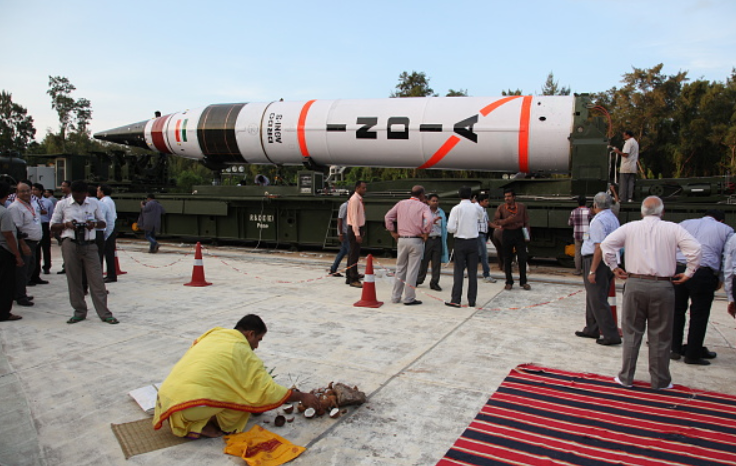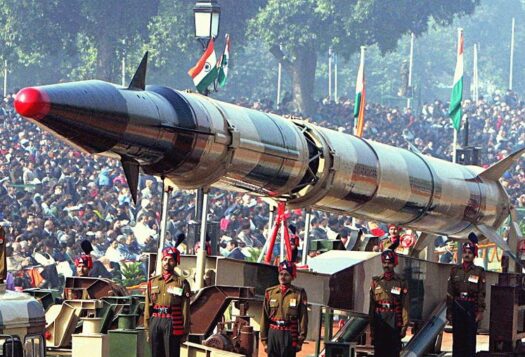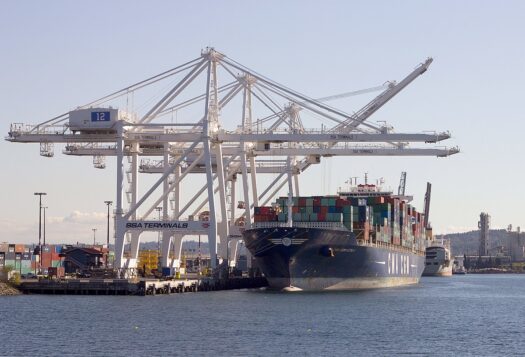
India’s nuclear strategy is guided by Credible Minimum Deterrence (CMD), which underscores the country’s No First Use (NFU) policy with second-strike capability. Although this policy has remained consistent since its inception, serving government officials and defense experts have questioned India’s commitment to NFU. India must balance maintaining its image as a responsible nuclear power while also keeping up with China’s expanding nuclear threat.
India’s missile development indicates its willingness to expand its deterrent capabilities. The success of the Agni V missile tests in December 2022 firmly puts it as a reliable payload delivery system. In October 2022, the INS Arihant also tested the short-range K15 SLBM. However, China’s rapidly expanding nuclear arsenal and uncertainty behind India’s thermonuclear capability puts India at a disadvantage regarding missile count and warhead reliability.
Missile and thermonuclear gaps between India and China remain strong drivers for India to adopt a more assertive nuclear stance to offset the Sino-Indian power asymmetry. However, scrapping NFU in favor of strategic ambiguity poses serious risks to strategic stability in South Asia and should only occur if India’s own threshold for acceptable risks is crossed. Instead, in the current environment, New Delhi should limit efforts to enhance its deterrent credibility to accelerating warhead acquisition.
Arms Race Asymmetries and Implications in Southern Asia
There is an order of magnitude between China’s rate of warhead development and India’s slow expansion. If India retains its CMD doctrine and maintains a low warhead development rate, India may soon find itself increasingly overmatched by Chinese nuclear expansion and unable to deter aggressive actions.
In the current environment, New Delhi should limit efforts to enhance its deterrent credibility to accelerating warhead acquisition.
China’s 2019 Defense White Paper aims to keep its nuclear capabilities at a “minimum level required for national security,” but this “minimum level” is based on China’s threat perception. It has decided that a massive expansion of its nuclear capabilities is needed to deter the United States. While China is trying to approach parity with the United States, rising strategic asymmetries increase threat perceptions in New Delhi. The U.S. Department of Defense estimated that China surpassed 400 warheads in 2021 and aims for 1,500 warheads by 2035. In comparison, India was estimated to have increased its warhead count from 156 to 160 in 2021. Additional plutonium plants necessary to significantly increase warhead development are not expected to be operational until the 2030s.
Moreover, India does not have assured capability of its thermonuclear weapons, damaging deterrent credibility. Whether improved warhead designs render Indian thermonuclear weapons reliable, the disparity between China’s successful thermonuclear explosion in 1967 and India’s reported thermonuclear fizzle in 1998 marks an area of Indian weakness that missile testing may not match. In the future, an Indian thermonuclear test can serve as an aggressive signal to China, but limited to extreme cases such as the stationing of PLA Rocket Force (PLARF) brigades in Tibet.
International Limitations
The United States is India’s most successful rapprochement; today, India is central to the United States’ strategy for countering China through the Indo-Pacific Framework. However, this rapprochement partially resulted from the U.S-India Civil Nuclear Agreement, which accompanied India’s waiver for access to the Nuclear Suppliers Group (NSG). These agreements were predicated on the understanding that India would voluntarily suspend nuclear tests. Thermonuclear testing would renege on the cornerstone of post-Cold War U.S-India relations and may crack the foundation of bilateral cooperation. Moreover, it could encourage increased aggression and build-up from Pakistan.
Pakistan poses a multidimensional security risk to India. Pakistan currently possesses more plutonium production reactors, a larger nuclear arsenal, and a more developed nuclear weapons production complex. If India accelerates the build-up of warheads, Pakistan will feel under threat. An arms race with Pakistan carries many risks, such as incentivizing asymmetric warfare, encouraging hawkish responses in New Delhi and Islamabad, and increasing threat perceptions on both sides. Should India choose to expand its nuclear arsenal, New Delhi will need to balance these knock-on effects.
By initiating nuclear tests, India also risks its access to fissile materials vis-à-vis the NSG. Although India possesses uranium deposits, India is still too heavily reliant on imports for its pressurized heavy water reactors to grow to self-sufficiency anytime soon. As India seeks to transition from fossil fuels, a strong push for nuclear energy will be vital for domestic energy and weapon production. India may risk having vital nuclear fuel imports cut off. NSG member states may regard tests as violating the waiver India was granted. Risking future energy production and access to uranium provides enough reason for India to tread carefully regarding CMD.

To be clear, India should not abandon NFU. The international community largely sees India as a responsible nuclear state, given its moderated approach to nuclear build-up and NFU. Rather than abandoning it, India’s commitment to NFU has been a major reputational success for India. India has strengthened its ties with the United States, Japan, Australia, and many others by engaging in civil nuclear and import agreements. These would be put at risk when adopting first use and conducting thermonuclear tests.
India and Pakistan both possess adequate nuclear arsenals to deter each other. However, India’s threat perceptions are changing. India faces pressure to expand its CMD to address a more aggressive China while taking care not to cross international thresholds. Abandoning NFU or testing a thermonuclear weapon would be provocative and trigger an international backlash. Instead, New Delhi must limit efforts to the acquisition of new warheads.
Future Contingencies
These recommendations do not preclude the possibility of future developments that will force India to abandon CMD completely. If more states acquire nuclear weapons, a CMD and NFU policy may put India at an aggregate disadvantage, even if the state is not expressly a threat to India. If states renege on their commitments to nonproliferation, India will face pressure to adopt a more active deterrent posture.
A modified CMD policy that balances accelerating warhead acquisitions with international thresholds will be India’s most likely course of action, given China’s ongoing nuclear build-up and border incursions.
India and China have not had to consider each other’s nuclear arsenal as a major threat so far, but the nuclear threat cannot be ignored. If China continues its inroads in Aksai Chin and Arunachal Pradesh, India will face a deterrent threat it will have difficulty matching. China’s increasing build-up and border aggression may tempt New Delhi to revisit and revise CMD. However, a change to a first-use policy might be a signal too big for China to ignore. China cannot afford to shift focus to India, while Taiwan and the South China Sea remains its primary area of interest. If well-timed, perhaps during a Taiwan crisis, New Delhi could remove CMD and NFU to overwhelm Beijing and force China to reconsider its actions. However attractive this approach may appear, it also carries significant risks of escalation.
Conclusion
CMD is both a strength and a weakness of India’s nuclear strategy. The benefits of traditional CMD make it a good choice for today’s India, allowing New Delhi to reap the benefits of not signing the NPT while gaining access to fissile materials. Still, a modified CMD policy that balances accelerating warhead acquisitions with international thresholds will be India’s most likely course of action, given China’s ongoing nuclear build-up and border incursions.
Nuclear doctrine should not be confused with nuclear dogma. If developments exceed India’s acceptable thresholds, New Delhi may be pressured to abandon NFU, even with the consequences. This is a scenario all states would be wise to avoid.
***


